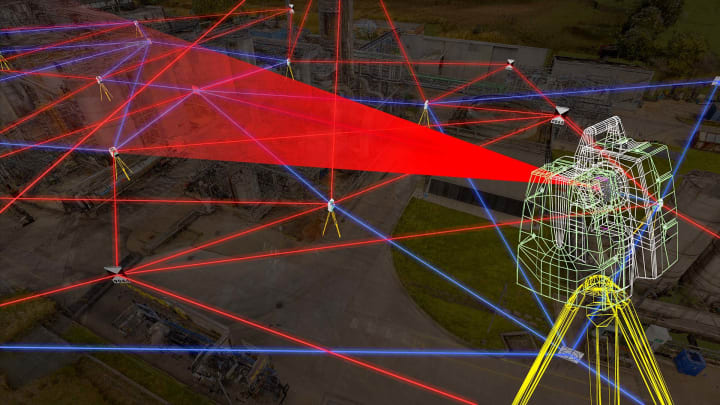Laser Scanning in Construction Across All Stages - Complete Guide
Future of Construction is Here: Explore the Power of Laser Scanning

Laser scanning, also known as LiDAR (Light Detection and Ranging) or High Definition Surveying (HDS), revolutionizes how construction projects capture data and progress through each stage. This guide explores its applications across all construction phases, highlighting its benefits and reliable resources to learn more.
What is Laser Scanning?

Laser scanning utilizes lasers to capture millions of data points, creating a highly detailed and accurate 3D representation of an environment. This data, known as a "point cloud," offers a deeper understanding of site conditions, building geometries, and as-built progress.
Benefits of Laser Scanning in Construction:
Imagine capturing a construction site's intricate details in minutes, not days, with precise millimeter-level accuracy. That's the power of laser scanning in construction. This technology delivers a treasure trove of benefits:
Enhanced Accuracy: Eliminate manual errors and gain millimeter-level precision for measurements and layouts.
Improved Efficiency: Scan entire sites in minutes, leading to faster data collection and quicker decision-making.
Reduced Rework: Identify potential clashes and discrepancies early, minimizing costly rework later in the project.
Better Communication: Visualize complex projects through 3D models, fostering collaboration and clearer communication amongst stakeholders.
Optimized Design: Integrate scan data into BIM models for better space utilization, clash detection, and design refinement.
Detailed Record Keeping: Create permanent as-built records for future maintenance, renovations, and facility management.
Applications Across Construction Stages:

Picture laser beams weaving a digital tapestry of your construction site, capturing every nook and cranny with unparalleled precision. This isn't science fiction; it's the power of laser scanning, revolutionizing how we tackle each stage of a project.
No longer confined to mere data collection, this technology permeates all phases, from pre-construction planning to post-construction management, leaving a trail of benefits in its wake.
Let's embark on a journey through these stages, unveiling how laser scanning transforms each one, unlocking efficiencies, enhancing accuracy, and fostering collaboration for project success.
1. Pre-construction:
- Site Surveying: Gather accurate topography, existing structures, and underground utility data for precise planning.
- Quantity Takeoffs: Accurately measure materials needed for foundations, excavations, and other elements.
- Clash Detection: Identify potential clashes between planned designs and existing conditions before construction begins.
2. Construction:
- Progress Monitoring: Track construction progress against plans and identify deviations for timely corrective action.
- Quality Control: Verify installed elements match design specifications and identify deviations requiring adjustment.
- Prefabrication: Generate precise measurements for prefabricated components, ensuring seamless integration onsite.
3. Post-construction:
Post-construction is the final phase of a construction project, encompassing all the activities that take place after the physical construction is complete but before the project is officially handed over to the owner. It's a crucial stage that ensures a smooth transition and addresses any outstanding issues before the owner takes possession.
Here's a breakdown of the key roles played by post-construction:
Completion and Finalization
Punch List: A detailed list of minor imperfections or incomplete tasks identified during the final inspection. The contractor addresses these items before final payment and handover.
Final Inspections: Conducted by various authorities (e.g., building department, fire marshal) to ensure compliance with codes and regulations.
Warranties and Guarantees: Issuing and registering warranties for materials and equipment used in the project.
Documentation and Handover
- As-built Documentation: Create a permanent record of the completed building for future reference and maintenance.
- Operation and Maintenance Manuals: Providing comprehensive instructions for operating and maintaining the building systems.
- Facility Management: Utilize 3D models for space management, equipment placement, and maintenance planning.
- Renovation and Expansion: Leverage existing building data for informed decision-making on future modifications.
3. Site Cleanup and Restoration
- Removal of construction debris and waste materials.
- Cleaning and landscaping the site.
- Restoring any disturbed areas to their original condition.
4. Closeout and Final Payment
- Resolving any outstanding issues with the contractor.
- Finalizing and settling all payments.
- Obtaining a certificate of occupancy, if required.
- Overall, post-construction plays a vital role in:
- Ensuring the quality and functionality of the completed project.
- Addressing any outstanding issues before handover.
Providing the owner with the necessary documentation and training to operate and maintain the building.
Successfully closing out the project and finalizing payments.
By effectively managing the post-construction phase, you can ensure a smooth transition, minimize delays, and guarantee the owner's satisfaction with the final product.
Additional Tips:
- Consider the project's scale, complexity, and budget when deciding on laser scanning equipment and expertise.
- Involve key stakeholders like architects, engineers, and contractors in the scanning and data integration process.
- Invest in training and software to maximize the benefits of laser scanning data.
By implementing laser scanning across all construction stages, you can achieve greater accuracy, efficiency, and project success. Start exploring these resources and embrace this transformative technology to revolutionize your construction projects!
Further Reading -
Scan to BIM for Construction Projects | Benefits & Application
About the Creator
Matt Sharon
A professional content writer. Having years of experience in Technology, health, finance, and construction and real estate field. Writing is my passion and I love to play with words Confidently.






Comments
There are no comments for this story
Be the first to respond and start the conversation.